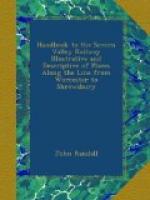LINLEY STATION.
The angler, desirous of a few hours’ amusement, may here find good sport at the fords, where the brooks come down and enter the river. Grayling and trout are often caught, and chub, less in favour with fishermen, of large size.
[Chub: 25.jpg]
If the tourist be a geologist he will find it pleasant to follow the course of Linley Brook, on the banks of which he may find fish of ancient date, in beds forming a passage from the Upper Ludlow to the Old Bed Sandstone. He will be interested, too, in noticing the angles at which the latter dip beneath the carboniferous strata, and these again beneath the overlying permians.
A series of interesting dingles now occur, where the nightingale is heard in May and June, through which whimpering streams come down, and where Tom Moody hunted with the famous “Willey Squire.” Tom’s exploits have been immortalised by Dibden in the song,—
“You all knew Tom Moody, the
whipper-in, well,
The bell that’s done tolling
is honest Tom’s knell.”
A plain slab in Barrow churchyard covers Tom’s remains, and simply records the date at which he died. At
COALPORT STATION,
Seven miles from Bridgnorth, and thirty-six from Worcester, the Severn is crossed by a handsome iron bridge, at the opposite extremity of which is the London and North-Western Company’s line to the Shropshire Union at Hadley.
The China Works are about five minutes’ walk from the station; they are extensive, and were established during the latter half of the last century, at which time they were removed here from Caughley. The productions are of a high order of merit, and combine those distinctive characters for which Caughley and Nantgarw were celebrated. They were successful, some years ago, in obtaining a medal awarded by the Society of Arts; in obtaining a First Class Exhibition Medal in 1851, also in 1855, and again in 1862. The works are very advantageously situated, having the river, the canal, and two railways adjoining.
The Art-Journal, in giving the history of these works, thus speaks of them: “The productions of the Coalport Works at the present day, thanks to the determination, energy, and liberality of the proprietor, take rank with the very best in the kingdom, both in body, in potting, in design, and in decoration; and there can be no doubt, from what is now actively in progress, that the stand taken by Coalport is one of enviable eminence among the ceramic manufactories of the world.”
Edge and Son’s chain and wire rope works are situated not far from these; and between the two, at the foot of the inclined plane, an ingenious device for transferring boats from one canal to the other, is the celebrated “Tar Tunnel,” driven into the coal measures, from which petroleum was formerly exported on a large scale, under the name of Betton’s British Oil.




